Continued from Part 1
[Note: This text includes names and descriptions now considered culturally disparaging. Please see our statement on “Potentially Offensive Text and Images.”]
THE FAIR AS A SPECTACLE.
How it seemed to a visitor—Strolling and dreaming by day and by night.
By Charles Mulford Robinson
Part 2: In Search of the Picturesque
But in that brief view a lesson was also taught you which you took to heart at once. It was that the charm of the Columbian Exposition, the thing that individualized it from its predecessors, was the wondrous beauty of its outward form. There have been numerous fairs, but never another so fair as this; and though the exhibits were the most complete that have been collected, it is so easy, unless one is a specialist, to be satiated; and beyond that point who cares how far the exhibits go? They made it a marvelous aggregation—indescribable because not to be realized, saddening in the very hopelessness of numbers. But this last view gave convincing proof that however one might note them here and there, the real spirit of the Fair lay not upon the counters; that the thing which differentiated this Exposition from all others was external beauty, that which was to be seen from the winding lagoons, the promenades, and courts and plazas. To them one inevitably returned on his first day’s journey in search of the picturesque.
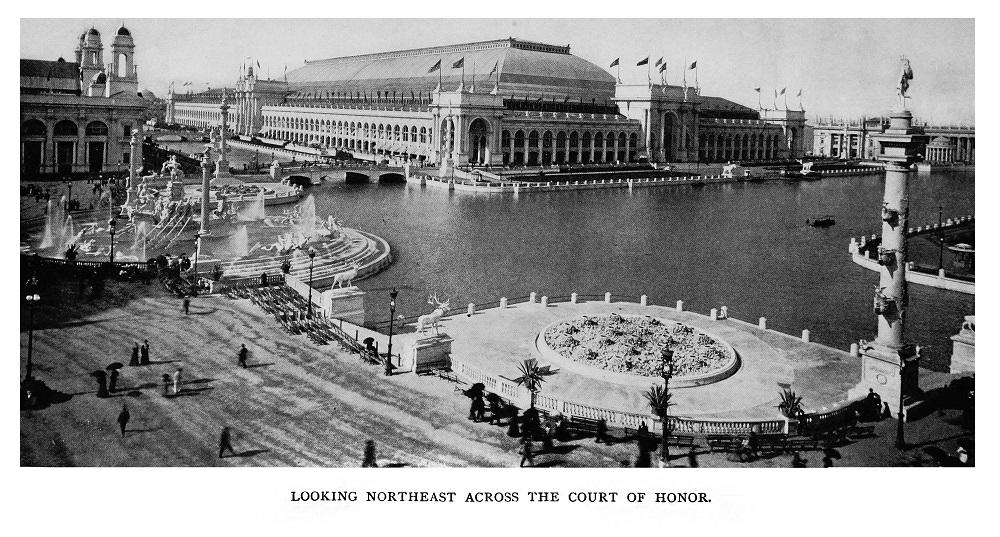
A view of part of the Court of Honor, showing the MacMonnies’ Fountain (on left) and the Manufactures and Liberal Arts Building (center). [Image from Johnson, Rossiter A History of the World’s Columbian Exposition Held in Chicago in 1893, Volume 1: Narrative. D. Appleton and Co., 1897.]
A subtle but irresistible charm of the Court of Honor was found to be its changeableness. It was never the same on successive days or even hours, and it differed even more widely from varying points of view. It had been astonishingly beautiful, but as yet the observer felt that its beauty was passive—as serene and cold as that of its own gilded figure of the
Republic. But as he left the Manufactures Building, crossed one of the graceful Venetian bridges, and entered Administration plaza, the Fair’s apparent character quickly changed. He recognized at once that he had reached the heart of the Exposition. The scene became theatrical, intensely vivacious, brilliant, almost nervous, against the calm background of white buildings and quiet lagoon. Here he suddenly felt his blood leap where before his spirits soared. A thousand details of which he could not be conscious at the moment contributed to the result—the great crowd of people, the music of the band, the fluttering of many flags, the constant hurried passage of those to whom the Fair was not a playground but an office, the lovely fountain, and even the Administration Building itself. Seen from a distance, the latter had had a calm and heavy dignity; but near at hand the crowded sculpture, the winged Victories holding out wreaths of triumph, the angels sounding trumpets over the entrance, the heroic figures of allegory, and finally the
Columbus with flying banner and uplifted sword and an inspired countenance and pose that threw into high relief the activity around him—all these affected the observer and made him conscious that at this point indeed was the life of the Fair. The coloring was rich. Here were red Venetian masts with brilliant banners, here a glory of flags and pennants, here the band stands gay with uniforms, and over all the gilded dome sent responding gleams to gilded Liberty across the blue Basin spotted with swift-gliding craft. The
Columbian Guards moved hither and thither on the plaza with martial tread and glory of uniform, but unfailingly patient and courteous when approached. In and out of the crowd the “gospel chariots,” as the people named the
wheeled chairs pushed by divinity students, threaded their way. Here surely, above all places, were activity and brilliancy at once!
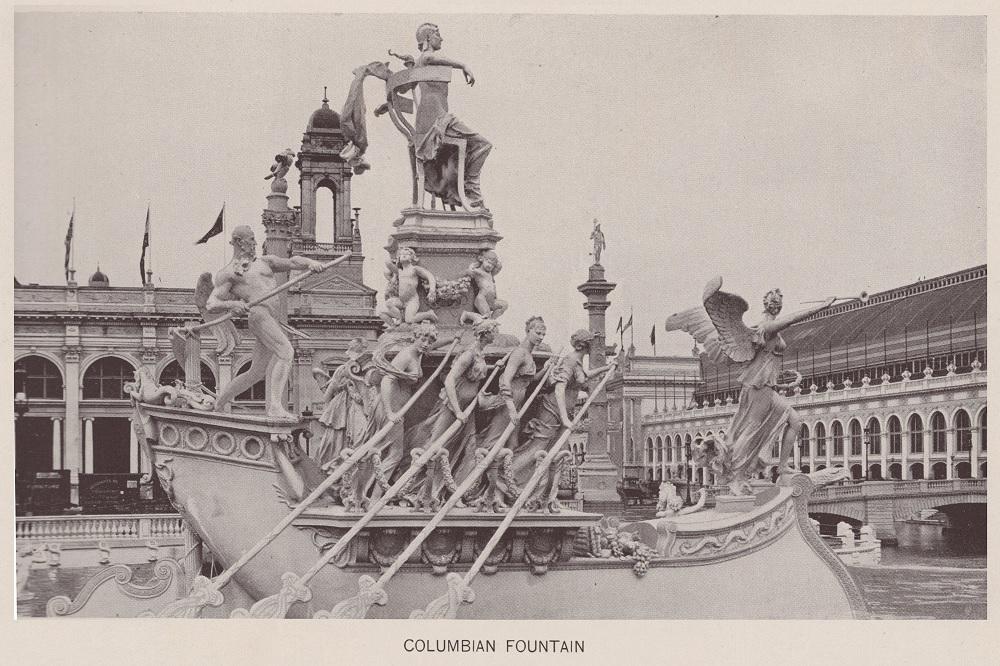
Frederick MacMonnies’ Columbian Fountain, with Time the helmsman, Fame the herald, and the Arts and Avocations propelling the craft. [Image from Arnold, C. D.; Higinbotham, H. D. Official Views of the World’s Columbian Exposition. Press Chicago Photo-gravure Co., 1893.]
And yet what a place in which to dream! The east side of the Plaza, facing the grand Basin, was separated from three fountains by a balustrade. The north and south fountains were electric, and played only at night; the middle one was the
Columbia. This beautiful, massive work—Time the helmsman, Fame the herald, and the Arts and Avocations propelling the craft with a show of such splendid speed and strength that it seemed as if the boat must pass quickly through the triumphal arch of the Peristyle and out upon the lake beyond—caused one’s thoughts to fly on with it and one’s consciousness to be lulled almost to sleep by the murmur of the water and the strains of music. The theatrical picturesqueness suddenly dimmed and was forgotten; the dreamer leaned alone on the balustrade and looked upon a Court of Honor that was all his own. Time was too busy steering Columbia to guide his thought, winged Fame sang the glory of only her one throned passenger, the Arts and Avocations need concern him no more, and Fancy ruled supreme. Here were born those dreams that peopled the Court of Honor with gods and goddesses, with princesses more lovely and knights more pure and powerful than ever dwelt outside the fields of legendry or of poetry, sung or thought. To the accompaniment of the running water of that lovely fountain, symbolizing indeed the triumph of Columbia, but typifying also the wondrous voyage of thought, the Court of the Dream City was here transformed to a court in the country of dream land, where the dreamer is a magician with limitless power. And yet—strongest testimony to the beauty around him—he could do no more than accept the environment and people it at his will!
This made a strange contrast for those who noticed it: the busy, crowded life of the Plaza and the edge of absorbed and idle dreamers. What a gulf flowed between the two, though they might touch elbows in the throng! It was a wharf with all its bustling scenes, and a phantom ship with a dreaming crew, her lines just cast off. It was theatrical again: a crowded stage and a listless, darkened audience with the curtain down between.
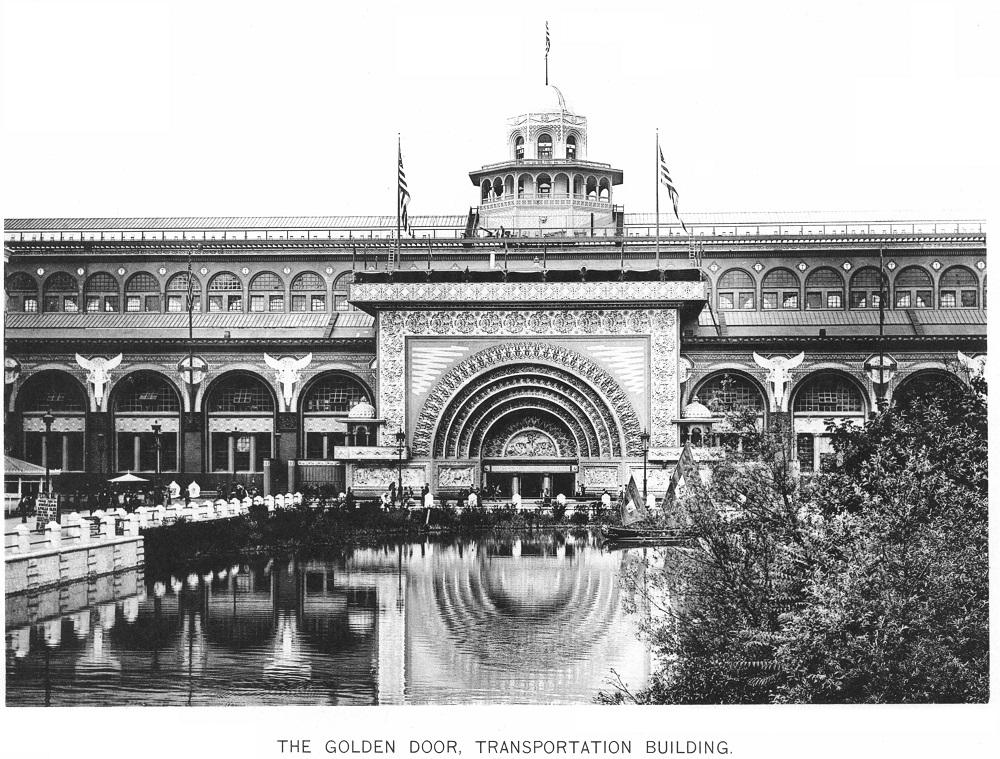
A view from the south bridge to the Wooded Island of the “Golden Door” of the Transportation Building, designed by Louis Sullivan. [Image from Arnold, C. D.; Higinbotham, H. D. Official Views of the World’s Columbian Exposition. Press Chicago Photo-gravure Co., 1893.]
As one left the Grand Court, many ways invited and each had something to commend it. From the Administration Plaza the avenue between the Electricity and Mines Buildings led to a bridge that crossed the lagoon to the
Wooded Island. From this bridge a beautiful view of the
Transportation Building was obtained, and directly opposite was the
Golden Door, that portal upon which seemed to glow all the sunlight that the rest of the Fair had missed. The palaces glittered in their whiteness, but theirs was a light as pure and clear as the moon’s. Deep reds and browns gave character to this building, and in the midst was the brilliant door of silvered yellow. Kiosks at either side, strange Egyptian panels on the wall, the recessed arches of the doorway, the geometrical figures, and the lavish ornament of the design, all seemed to emphasize the voluptuous Orientalism of the building among the sterner vestal structures seen before.
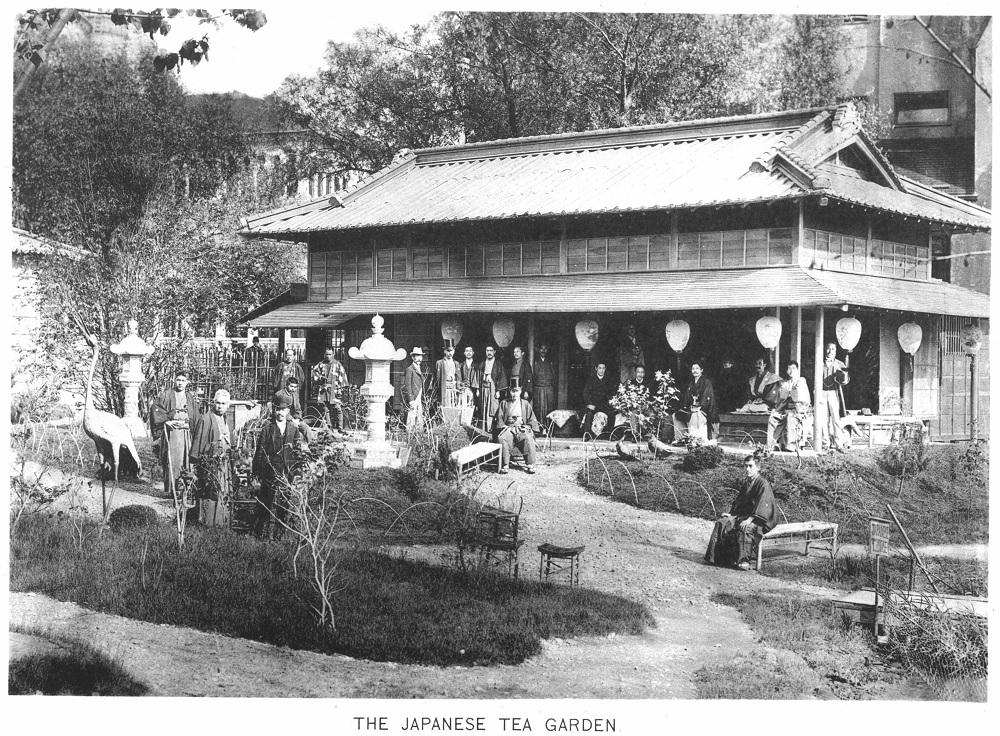
The Japanese Tea House was not located on the Wooded Island (as stated in Robinson’s essay), but just north, next to the Café de la Marine. [Image from Arnold, C. D.; Higinbotham, H. D. Official Views of the World’s Columbian Exposition. Press Chicago Photo-gravure Co., 1893.]
To leave this bride of the Orient and walk on the Wooded Island was to enter the country of the bride. Trees cast a grateful shade, paths took the place of walks of asphalt, and the air was sweet with the fragrance of hundreds of roses. Here and there enticing paths wound away to find Love’s dear seclusion, and yonder, over the bushes, rose the
gabled roofs of Japan! Very picturesque and inviting proved the little bamboo structures, where, beneath the swinging paper lanterns and in the shadow of the trees, the soft-voiced children of the East, with the gentle manner and courtesy born of centuries, served wafers and tea. The noises of the Fair were far away; hidden was the inspiring grandeur of its mighty buildings; veiled its richest colors; and peace and simplicity prevailed. Here was just the blue of the sky, the green of the grass and trees. Paper fans of the jumping-jack style were given as souvenirs, and the visitors were children again, with the gentlest of grown-up little folk to wait upon them; tired, with a cup of tea to soothe them; eye-weary, with Nature’s familiar scenes for rest. Idly the people came and went, strolling in and out—a constant change without a crowd.
The throng was made up of all kinds of persons. It was not like the surging stream of unanalyzed humanity that was seen in the Manufactures Building, which wearied one because it seemed impersonal. Here you saw just how tired and cross were some people, and how fresh and good-natured were others. You wondered about the relationships in the parties that came and went; and it struck you, as you thought of the various nations these wanderers represented, how much alike we have all become; how one is necessarily a citizen of the world now, not because he travels but because the world is traveling about him and he can not help it. Within the confines of civilization we are brothers and sisters indeed, with almost a fraternal lack of vivid curiosity regarding one another.

The Japanese Ho-o-den on the Wooded Island. [Image from Arnold, C. D.; Higinbotham, H. D. Official Views of the World’s Columbian Exposition. Press Chicago Photo-gravure Co., 1893.]
There was little that was startling in this Japanese pavilion in the heart of the American continent. The paper lanterns swung from the bamboo rods as if at home, the American breeze that tossed them treated their foreign origin with no respect, and so also the various people passed indifferently. A little French, Italian, Spanish, German, English, was overheard; but it was all said with a similar shrug or smile, and you guessed that it was the same thought. Everything was incongruous, yet in a way everything harmonized, because it was so accepted; and it seemed only mildly interesting, not strange, that an American college boy should greet the Jap who served him tea as a “brother,” should give to him the secret grip of his fraternity, and talk in English of their college pranks. Yet truly this was Japanese tea that you sipped, if you liked, in the true Japanese style.
The tea-houses were near the northern end of the island, not far from a bridge leading again to the Dream City. Electric launches glided swiftly up and down the winding lagoon, and, embarking at an ornamental landing, one was hurried away smoothly, luxuriously, deliciously, over the cool water, past the bushes that fringed the Wooded Island, past the waterfowl that paddled quickly into shelter, past the swans floating like living chips fallen from the white structures on the shore, past buildings of the States and nations that gave a new respect for geographical divisions in showing that differences in size and color are not the most important ethnological variations, past other launches and gay Venetian gondolas, and around at last to the great art palace, whose widespread arms prevented farther progress.
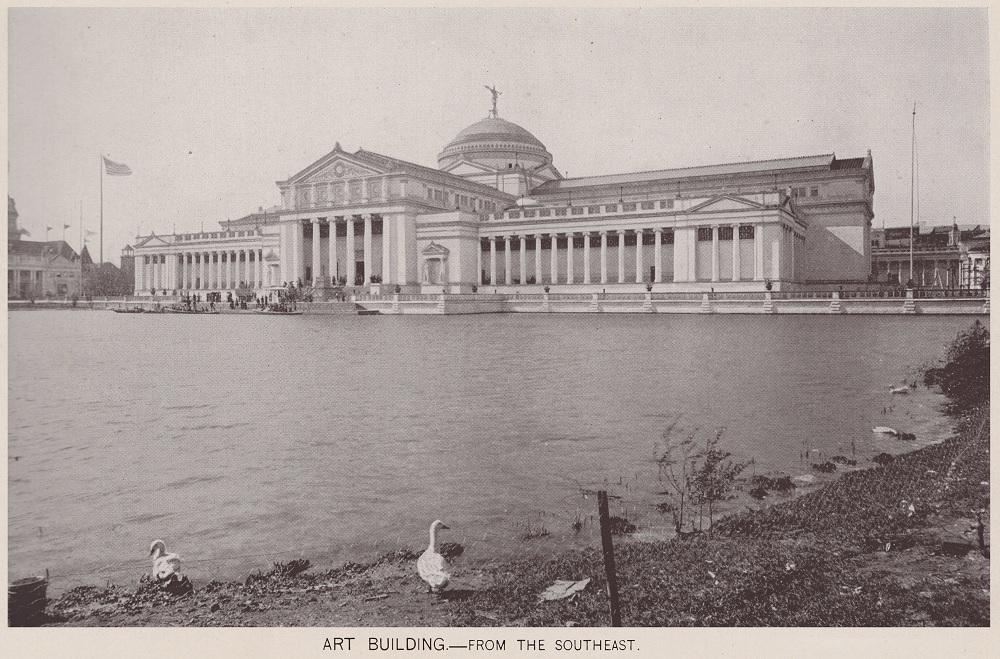
The Palace of Fine Arts, designed by Charles B. Atwood, as viewed from the southeast. [Image from Arnold, C. D.; Higinbotham, H. D. Official Views of the World’s Columbian Exposition. Press Chicago Photo-gravure Co., 1893.]
The
Art Building was poised at the edge of the pond, seemingly studying the reflection of its own chaste beauty, and at the same time dominating the scene by its massiveness and grandeur. It had thus a solitude that was given to no other building—or rather it assumed this, dwarfing all surroundings save the waters that so fairly mirrored it. Pure Grecian, it stood sublime and calm as a goddess. The caryatides that supported the cornice of the portico and the ornamental porches at either side were like worshipers; the long row of Ionic columns seemed like a line of suppliant arms, the beautiful low-rounded dome was as the simple ancient wreath that crowned a divinity. Every sense of the observer was satisfied, and the garlanded word “Art” above the portal was hardly necessary. Like the rich, full tone of a bell it rang out the one utterance of that beautiful building, its note in the chord of the Fair, its whisper to thrill the observer. The building thus fixed behind the statue of
Minerva was as the word following her look. Up and down the broad stairway surged the people. They were devotees of art; conscious and unconscious seekers of the beautiful; nervous, restless, humanity reaching out for that calm repose and majesty, toiling after it with pitiful earnestness; hushed when once within its sacred precincts, and stilled by memory’s visions as the temple was left. “Art” was its one expression;
Ars longa, vita brevis the ancient message of the scene.
The Woman’s Building, opposite the northwestern end of the Wooded Island, was a light, graceful building, all the whiter for the growing plants on roof and colonnade. The detached columns, open arches, and ornamental sculpture made the structure like a bit of architectural lace coming after Art’s stern dignity; a woman’s winning smile after Beauty’s firm resolve.
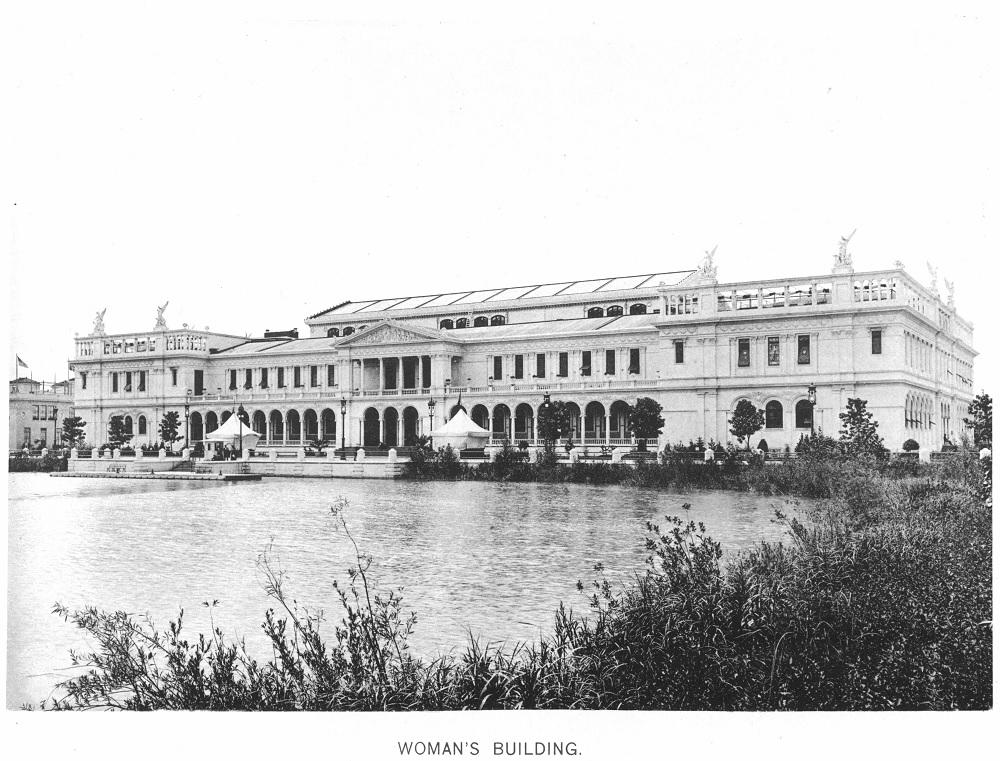
The Woman’s Building, designed by Sophia Hayden. [Image from Arnold, C. D.; Higinbotham, H. D. Official Views of the World’s Columbian Exposition. Press Chicago Photo-gravure Co., 1893.]








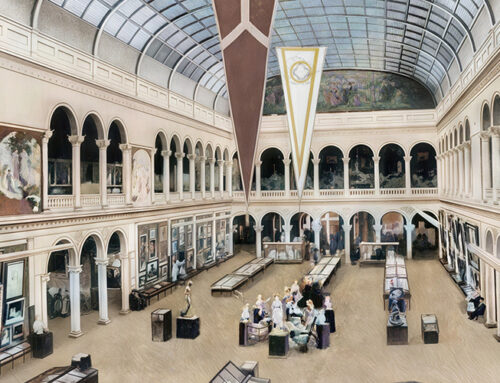
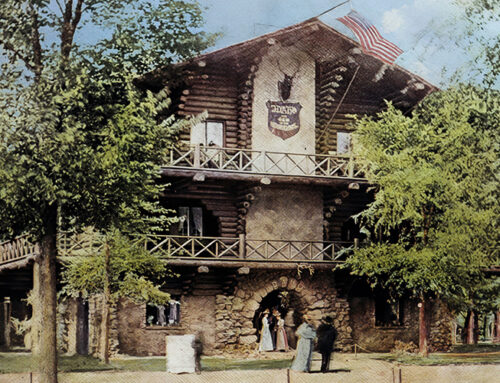
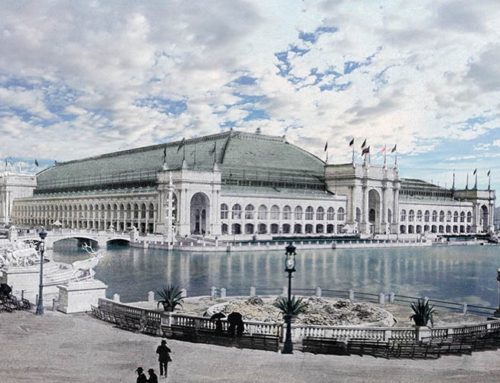
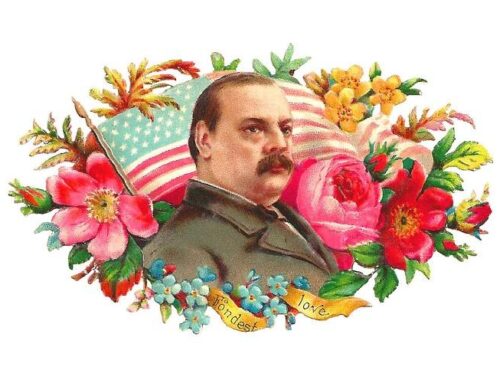
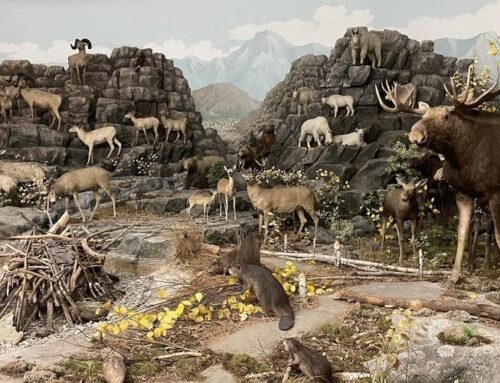
As a Chicago history buff, I found these first parts not only interesting but educational also. Thank you for this experience.